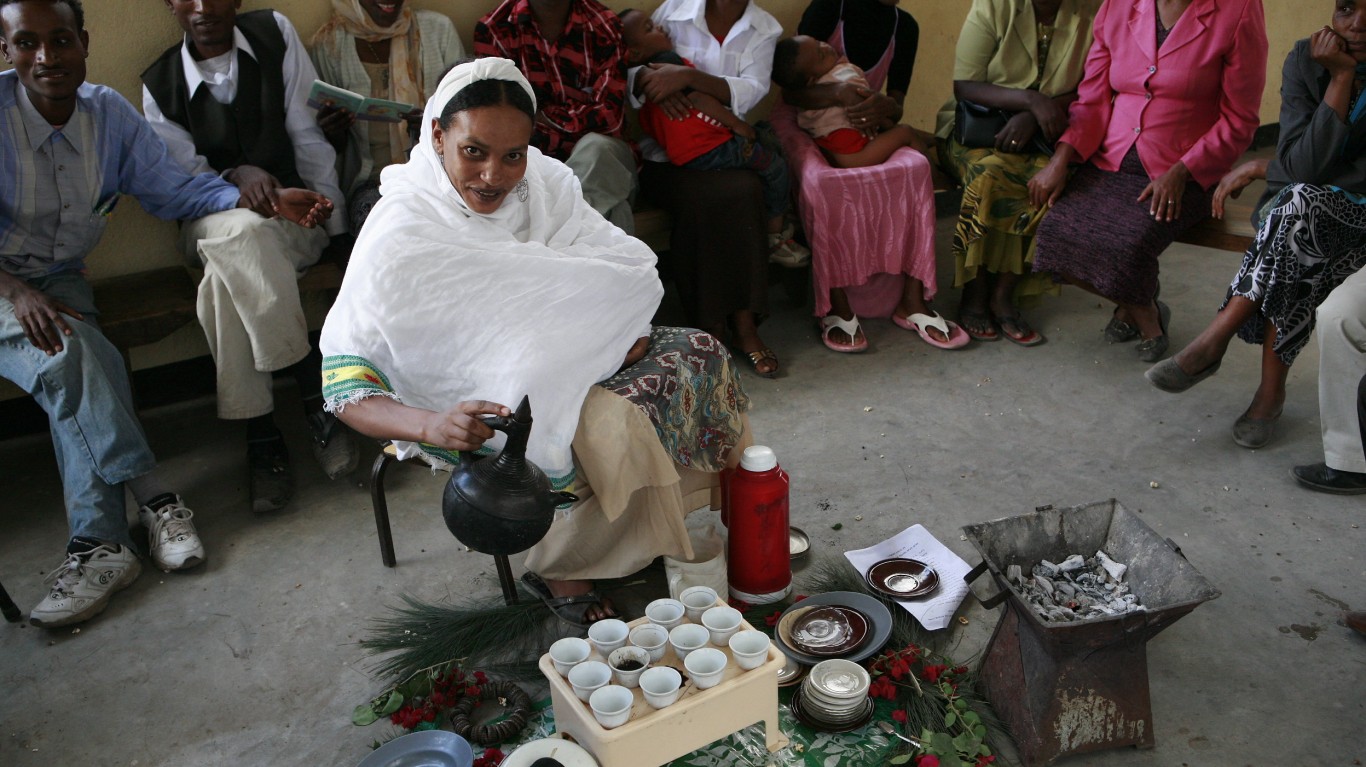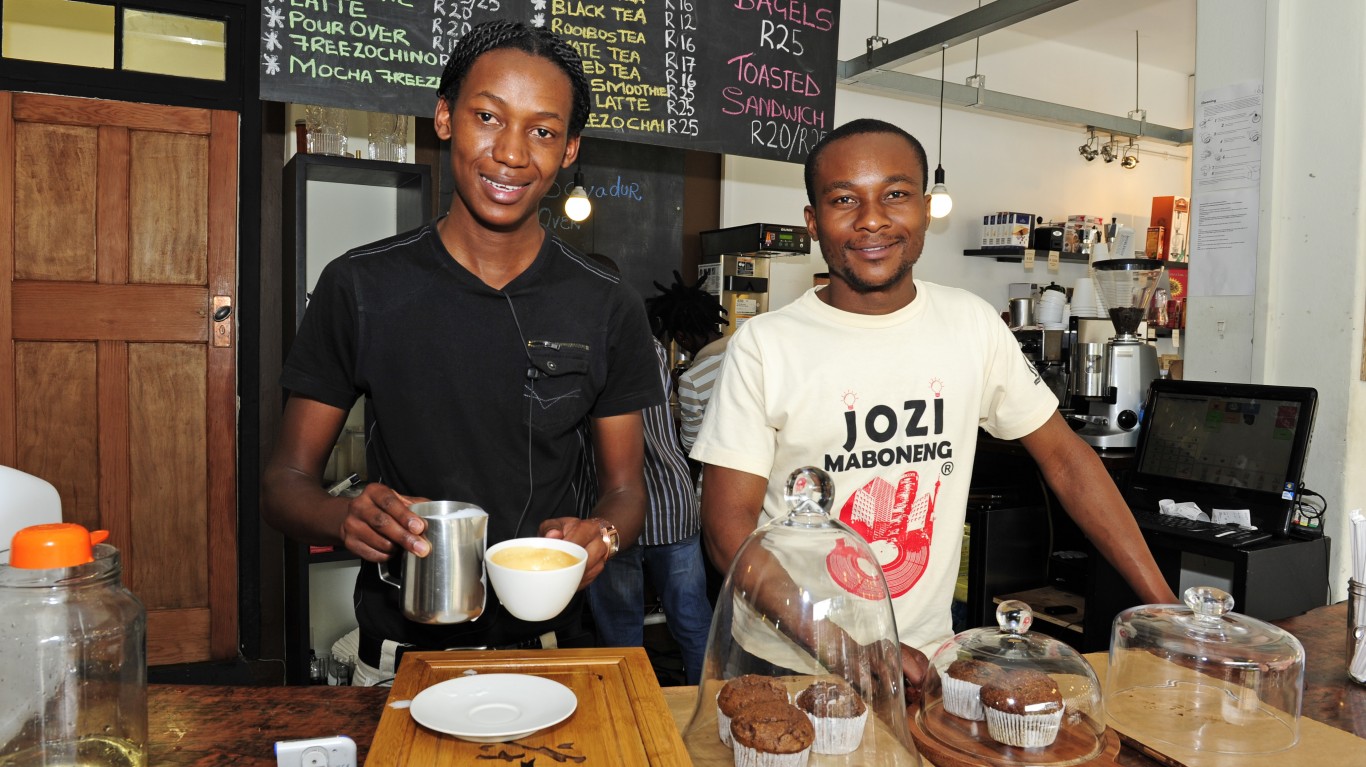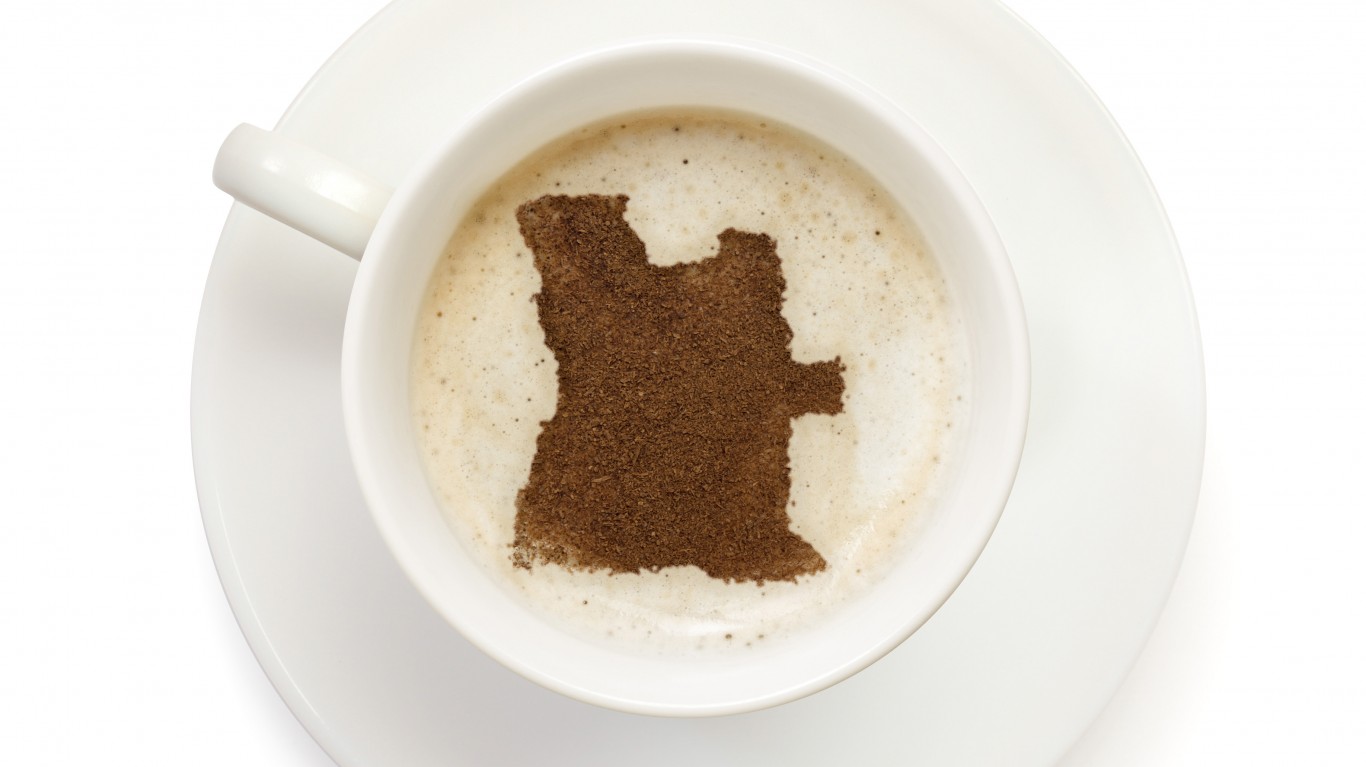Special Report
The Price of a Cup of Coffee Around the World

Published:
Last Updated:

Americans are setting records when it comes to drinking coffee. Nearly 65% of adults in the country have at least one cup of coffee every day, an increase from 62% in 2017 and the highest share of coffee drinkers since 2012.
Whether you like the smell or because it improves your focus, whether you find that it helps with your mood or because you like the taste of it, coffee is undoubtedly the go-to drink in the morning for most people.
One of the most popular caffeinated drinks is the cappuccino, especially in Europe. Originally from Italy, where it is usually consumed in the morning, a regular cappuccino contains an equal amounts of espresso, steamed milk, and foamed milk. A single shot of espresso in the beverage has between 6 and 8 grams of coffee.
The local price of cappuccino varies greatly across the world, even in countries with similar purchasing power per person. For example, Angola and Vietnam both have a GDP per capita of about $7,000, but price of cappuccino is 2.5 times higher in the Southern African country.
Finland drinks the most coffee per capita, with more than 26 lbs. per person a year, followed by Norway and Iceland. However, much of the coffee in the world is produced in developing countries, with Brazil being the top exporter, accounting for over 14% of the total coffee exports.
Click here to see the price of a cup of coffee in the world’s largest countries.
Click here to read our methodology.

1. India
> 2017 working age population: 967.1 million
> Price of regular cappuccino: $1.47
> 2017 GDP per capita $7,194
> Coffee consumption per working age adult: 13 cups per year
> Total domestic consumption: 304.3 million lbs.
[in-text-ad]

2. United States
> 2017 working age population: 264.1 million
> Price of regular cappuccino: $4.02
> 2017 GDP per capita $59,792
> Coffee consumption per working age adult: 552 cups per year
> Total domestic consumption: 3.4 billion lbs.

3. Indonesia
> 2017 working age population: 191.8 million
> Price of regular cappuccino: $1.91
> 2017 GDP per capita $12,404
> Coffee consumption per working age adult: 136 cups per year
> Total domestic consumption: 608.6 million lbs.

4. Brazil
> 2017 working age population: 163.8 million
> Price of regular cappuccino: $1.60
> 2017 GDP per capita $15,637
> Coffee consumption per working age adult: 734 cups per year
> Total domestic consumption: 2.8 billion lbs.
[in-text-ad-2]

5. Russian Federation
> 2017 working age population: 119.1 million
> Price of regular cappuccino: $1.91
> 2017 GDP per capita $27,893
> Coffee consumption per working age adult: 221 cups per year
> Total domestic consumption: 613.6 million lbs.

6. Japan
> 2017 working age population: 110.4 million
> Price of regular cappuccino: $3.49
> 2017 GDP per capita $42,942
> Coffee consumption per working age adult: 406 cups per year
> Total domestic consumption: 1.0 billion lbs.
[in-text-ad]

7. Nigeria
> 2017 working age population: 106.9 million
> Price of regular cappuccino: $2.39
> 2017 GDP per capita $5,941
> Coffee consumption per working age adult: 2 cups per year
> Total domestic consumption: 5.3 million lbs.

8. Mexico
> 2017 working age population: 94.7 million
> Price of regular cappuccino: $1.99
> 2017 GDP per capita $19,938
> Coffee consumption per working age adult: 137 cups per year
> Total domestic consumption: 304.3 million lbs.

9. Vietnam
> 2017 working age population: 73.5 million
> Price of regular cappuccino: $1.72
> 2017 GDP per capita $6,928
> Coffee consumption per working age adult: 185 cups per year
> Total domestic consumption: 317.5 million lbs.
[in-text-ad-2]

10. Germany
> 2017 working age population: 71.9 million
> Price of regular cappuccino: $3.04
> 2017 GDP per capita $50,804
> Coffee consumption per working age adult: 120 cups per year
> Total domestic consumption: 201.1 million lbs.

11. Philippines
> 2017 working age population: 71.6 million
> Price of regular cappuccino: $2.02
> 2017 GDP per capita $8,360
> Coffee consumption per working age adult: 237 cups per year
> Total domestic consumption: 396.9 million lbs.
[in-text-ad]

12. Egypt, Arab Rep.
> 2017 working age population: 64.9 million
> Price of regular cappuccino: $1.56
> 2017 GDP per capita $12,698
> Coffee consumption per working age adult: 15 cups per year
> Total domestic consumption: 23.4 million lbs.

13. Ethiopia
> 2017 working age population: 62.4 million
> Price of regular cappuccino: $0.75
> 2017 GDP per capita $2,165
> Coffee consumption per working age adult: 338 cups per year
> Total domestic consumption: 492.8 million lbs.

14. Turkey
> 2017 working age population: 60.6 million
> Price of regular cappuccino: $1.71
> 2017 GDP per capita $27,049
> Coffee consumption per working age adult: 129 cups per year
> Total domestic consumption: 182.3 million lbs.
[in-text-ad-2]

15. Thailand
> 2017 working age population: 57.1 million
> Price of regular cappuccino: $1.88
> 2017 GDP per capita $17,894
> Coffee consumption per working age adult: 129 cups per year
> Total domestic consumption: 172.0 million lbs.

16. France
> 2017 working age population: 55.0 million
> Price of regular cappuccino: $3.01
> 2017 GDP per capita $44,081
> Coffee consumption per working age adult: 157 cups per year
> Total domestic consumption: 201.1 million lbs.
[in-text-ad]

17. United Kingdom
> 2017 working age population: 54.3 million
> Price of regular cappuccino: $3.33
> 2017 GDP per capita $44,292
> Coffee consumption per working age adult: 158 cups per year
> Total domestic consumption: 201.1 million lbs.

18. Italy
> 2017 working age population: 52.4 million
> Price of regular cappuccino: $1.53
> 2017 GDP per capita $38,233
> Coffee consumption per working age adult: 164 cups per year
> Total domestic consumption: 201.1 million lbs.

19. South Africa
> 2017 working age population: 40.3 million
> Price of regular cappuccino: $1.83
> 2017 GDP per capita $13,573
> Coffee consumption per working age adult: 83 cups per year
> Total domestic consumption: 77.9 million lbs.
[in-text-ad-2]

20. Spain
> 2017 working age population: 39.7 million
> Price of regular cappuccino: $1.77
> 2017 GDP per capita $38,381
> Coffee consumption per working age adult: 217 cups per year
> Total domestic consumption: 201.1 million lbs.

21. Ukraine
> 2017 working age population: 37.9 million
> Price of regular cappuccino: $0.92
> 2017 GDP per capita $8,754
> Coffee consumption per working age adult: 167 cups per year
> Total domestic consumption: 148.2 million lbs.
[in-text-ad]

22. Colombia
> 2017 working age population: 37.5 million
> Price of regular cappuccino: $1.22
> 2017 GDP per capita $14,437
> Coffee consumption per working age adult: 262 cups per year
> Total domestic consumption: 229.7 million lbs.

23. Argentina
> 2017 working age population: 33.3 million
> Price of regular cappuccino: $1.60
> 2017 GDP per capita $20,918
> Coffee consumption per working age adult: 101 cups per year
> Total domestic consumption: 78.9 million lbs.

24. Poland
> 2017 working age population: 32.3 million
> Price of regular cappuccino: $2.10
> 2017 GDP per capita $29,642
> Coffee consumption per working age adult: 266 cups per year
> Total domestic consumption: 201.1 million lbs.
[in-text-ad-2]

25. Tanzania
> 2017 working age population: 31.6 million
> Price of regular cappuccino: $1.82
> 2017 GDP per capita $3,247
> Coffee consumption per working age adult: 16 cups per year
> Total domestic consumption: 12.0 million lbs.

26. Canada
> 2017 working age population: 30.8 million
> Price of regular cappuccino: $3.05
> 2017 GDP per capita $48,390
> Coffee consumption per working age adult: 695 cups per year
> Total domestic consumption: 500.5 million lbs.
[in-text-ad]

27. Kenya
> 2017 working age population: 29.6 million
> Price of regular cappuccino: $2.34
> 2017 GDP per capita $3,502
> Coffee consumption per working age adult: 10 cups per year
> Total domestic consumption: 6.6 million lbs.

28. Algeria
> 2017 working age population: 29.2 million
> Price of regular cappuccino: $0.66
> 2017 GDP per capita $15,167
> Coffee consumption per working age adult: 431 cups per year
> Total domestic consumption: 294.1 million lbs.

29. Morocco
> 2017 working age population: 25.9 million
> Price of regular cappuccino: $1.56
> 2017 GDP per capita $8,568
> Coffee consumption per working age adult: 130 cups per year
> Total domestic consumption: 78.9 million lbs.
[in-text-ad-2]

30. Saudi Arabia
> 2017 working age population: 24.6 million
> Price of regular cappuccino: $2.82
> 2017 GDP per capita $54,532
> Coffee consumption per working age adult: 328 cups per year
> Total domestic consumption: 189.2 million lbs.

31. Sudan
> 2017 working age population: 24.0 million
> Price of regular cappuccino: $0.72
> 2017 GDP per capita $4,349
> Coffee consumption per working age adult: 38 cups per year
> Total domestic consumption: 21.2 million lbs.
[in-text-ad]

32. Peru
> 2017 working age population: 23.4 million
> Price of regular cappuccino: $2.36
> 2017 GDP per capita $13,521
> Coffee consumption per working age adult: 61 cups per year
> Total domestic consumption: 33.1 million lbs.

33. Venezuela
> 2017 working age population: 23.2 million
> Price of regular cappuccino: $0.72
> 2017 GDP per capita $12,514
> Coffee consumption per working age adult: 403 cups per year
> Total domestic consumption: 218.3 million lbs.

34. Uganda
> 2017 working age population: 22.4 million
> Price of regular cappuccino: $1.82
> 2017 GDP per capita $2,367
> Coffee consumption per working age adult: 61 cups per year
> Total domestic consumption: 31.8 million lbs.
[in-text-ad-2]

35. Yemen, Rep.
> 2017 working age population: 17.0 million
> Price of regular cappuccino: $2.07
> 2017 GDP per capita $2,456
> Coffee consumption per working age adult: 43 cups per year
> Total domestic consumption: 17.2 million lbs.

36. Angola
> 2017 working age population: 15.8 million
> Price of regular cappuccino: $4.22
> 2017 GDP per capita $6,835
> Coffee consumption per working age adult: 11 cups per year
> Total domestic consumption: 4.0 million lbs.
Methodology
To determine the cost of a cappuccino in the world’s largest countries, 24/7 Wall St. first identified the 50 largest countries based on total population with data from the International Monetary Fund. The dollar price of a regular cappuccino was taken from Numbeo, a database of user-contributed information about countries. Of the 50 largest countries, we only included the 36 for which coffee consumption data is available.
For the number of daily cups of coffee per every person of working age, specified by the IMF as 15 and over, we assumed one 6 fl. oz. cup contains two tablespoons, or 10.6 grams of coffee, which is the standard. We reviewed historical data on global coffee trade provided by the International Coffee Organization.
The European Union was listed as one collective unit in the ICO data. To get an estimate of how many cups of coffee every adult in each EU country drinks, we took the total amount of coffee consumed in the EU and divided it by the number of countries in the EU. The average was then divided per the number of population of the specific EU countries on the list. We divided the total consumption data by the number of working-age people and the amount of coffee in a cup.
Gross domestic product per capita also came from the IMF.
The Average American Is Losing Momentum On Their Savings Every Day (Sponsor)
If you’re like many Americans and keep your money ‘safe’ in a checking or savings account, think again. The average yield on a savings account is a paltry .4%1 today. Checking accounts are even worse.
But there is good news. To win qualified customers, some accounts are paying more than 7x the national average. That’s an incredible way to keep your money safe and earn more at the same time. Our top pick for high yield savings accounts includes other benefits as well. You can earn a $200 bonus and up to 7X the national average with qualifying deposits. Terms apply. Member, FDIC.
Click here to see how much more you could be earning on your savings today. It takes just a few minutes to open an account to make your money work for you.
Thank you for reading! Have some feedback for us?
Contact the 24/7 Wall St. editorial team.